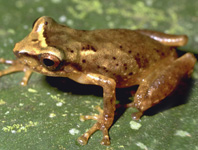Abstract
A fossil of a mayfly nymph that shows similarities with the modern genus Teloganella Ulmer, 1939 of the family Teloganellidae is recorded for the first time from the Indian subcontinent. It is systematically described from the Gurha lignite mine of Bikaner, Rajasthan which belongs to the Palana Formation (late Paleocene-early Eocene). As assignment of the fossil to a modern species of Teloganella is difficult due to indistinguishable location of gills in the impression, a new species, Teloganella gurhaensis Agnihotri et al., sp. nov. is instituted to include this fossil naiad resembling the extant Teloganella.
References
Dutta, K.K. (1971) Lignite deposits of Palana. Memoirs of the Geological Survey of India, 88, 426–428.
Edmunds, G.F. Jr. & Polhemus, D.A. (1990) Zoogeographical patterns among mayflies (Ephemeroptera) in the Malay Archipelago, with special reference to Celebes. in: Knight, W.J. & Holloway, J.D. (Eds.), Insects and the rain forests of south east Asia (Wallacea). Royal Entomological Society of London, London, pp. 49–56.
Grimaldi, D.A. & Singh, H. (2012) The extinct genus Pareuthychaeta in Eocene ambers (Diptera: Schizophora: Ephydroidea). The Canadian Entomologist, 144, 17–28.
https://doi.org/10.4039/tce.2012.5
Jacobus, L.M. & McCafferty, W.P. (2006) Reevaluation of the phylogeny of the Ephemeroptera infraorder Pannota (Furcatergalia), with adjustments to higher classification. Transactions of the American Entomological Society, 132, 81–90.
https://doi.org/10.3157/0002-8320(2006)132[81:ROTPOT]2.0.CO;2
Jolly, A. & Loyal, R.S. (1985) Record of microvertebrates from the Middle Eocene Marh Stage of Sri Kolayat-Ji, Rajasthan. Bulletin of the Geological Mining and Metallurgical Society of India, 52, 374–384.
Kalia, P. & Sharma, R. (1985) Planktonic foraminiferal biostratigraphy of the Kolayat Formation (lower Middle Eocene), Bikaner District, Rajasthan. Bulletin of the Geological, Mining and Metallurgical Society of India, 52, 20–36.
Kania, I., Krzeminski, W., Stebner, F. & Singh, H. (2018) The first representative of Tipulomorpha (Diptera) from Early Eocene Cambay amber (India). Earth and Environmental Science Transactions of the Royal Society of Edinburgh, 107, 263–269.
https://doi.org/10.1017/S1755691017000433
Khosla, S.C. (1971) Classification of the Lower Tertiary beds of Rajasthan. Bulletin of the Indian Geologists’ Association, 4, 54–60.
Kluge, N.J. (2004) The phylogenetic system of Ephemeroptera. Kluwer Academic Publishers, Dordrecht, 456 pp.
https://doi.org/10.1007/978-94-007-0872-3
Kluge, N.J., Selvakumar, C., Sivaramakrishnan, K.G. & Jacobus, L.M. (2015) Contribution to the knowledge of the mayfly genus Teloganella Ulmer, 1939 (Ephemeroptera: Ephemerelloidea). Zootaxa, 4028 (2), 287–295.
https://doi.org/10.11646/zootaxa.4028.2.8
Kulshreshtha, S.K., Singh, R.Y. & Sobeh, A.Y. (1989) Stratigraphy of the Lower Tertiary sediments in Bikaner, western Rajasthan. In: Kalia, P. (Ed.), Micro-palaeontology of the shelf sequences of India. Proceedings of XII Indian Colloquium on Micropalaeontology and Stratigraphy. Papyrus Publishing House, New Delhi, pp. 193–202.
Kumar, K. & Loyal, R.S. (1987) Eocene ichthyofauna from the Subathu Formation, northwestern Himalaya, India. Journal of the Palaeontological Society of India, 32, 60–84.
Kumar, K., Rana, R.S. & Paliwal, B.S. (2005) Osteoglossid and lepisosteid fish remains from the Palaeocene Palana Formation, Rajasthan, India. Palaeontology, 48 (6), 1187–1209.
https://doi.org/10.1111/j.1475-4983.2005.00519.x
La Touche, T.D. (1897) Report on the occurrence of coal at Palana village in Bikanir State. Records of the Geological Survey of India, 30, 122–125.
McCafferty, W.P. & Wang, T.Q. (2000) Phylogenetic systematics of the major lineages of Pannote mayflies (Ephemeroptera, Pannota). Transactions of the American Entomological Society, 126, 9–101.
Ogden, T.H., Gattolliat, J.L., Sartori, M., Staniczek, A.H., Soldán, T. & Whiting, M.F. (2009) Towards a new paradigm in mayfly phylogeny (Ephemeroptera): combined analysis of morphological and molecular data. Systematic Entomology, 34, 616–634.
https://doi.org/10.1111/j.1365-3113.2009.00488.x
Pareek, H.S. (1984) Pre-Quaternary geology and mineral resources of northwestern Rajasthan. Memoirs of the Geological Survey of India, 115, 1–99.
Peters, W.L. & Peters, J.G. (1993) Status changes in Leptohyphidae and Tricorythidae (Ephemeroptera). Aquatic Insects, 15, 45–48.
https://doi.org/10.1080/01650429309361499
Sartori, M., Derleth, P. & Gattolliat, J.L. (2003) New data about the mayflies (Ephemeroptera) from Borneo. in: Gaino, E. (Ed.), Research update on Ephemeroptera & Plecoptera. Universita di Perugia, Perugia, pp. 403–406.
Selvakumar, C., Sivaramakrishnan, K.G., Jacobus, L.M., Janarthanan, S. & Arumugam, M. (2014) Two new genera and five new species of Teloganodidae (Ephemeroptera) from South India. Zootaxa, 3846 (1), 87–104.
https://doi.org/10.11646/zootaxa.3846.1.4
Shukla, A., Mehrotra, R., Spicer, R.A. & Kumar, M. (2014) Cool equatorial terrestrial temperatures and the South Asian monsoon in the Early Eocene: Evidence from the Gurha Mine, Rajasthan, India. Palaeogeography Palaeoclimatology Palaeoecology, 412, 187–198.
https://doi.org/10.1016/j.palaeo.2014.08.004
Singh, S.N. (1971) Planktonic foraminifera in the Eocene stratigraphy of Rajasthan, India. Proceedings of the 2nd International Conference on Planktonic Microfossils, Rome, 2, 1169–1181.
Sites, R.W., Wang, T., Permkam, S. & Hubbard, M.D. (2001) The mayfly genera (Ephemeroptera) of southern Thailand. Natural History Bulletin of the Siam Society, 49, 243–268.
Soldán, T. (2001) Status of the systematic knowledge and priorities in Ephemeroptera studies: the Oriental Region. In: Dominguez, E. (Ed.), Trends in Research in Ephemeroptera & Plecoptera. Kluwer Academic/Plenum Publishers, New York, pp. 53–65.
https://doi.org/10.1007/978-1-4615-1257-8_9
Stebner, F., Szadziewski, R., Singh, H., Gunkel, S. & Rust, J. (2017) Biting midges (Diptera: Ceratopogonidae) from Cambay amber indicate that the Eocene fauna of the Indian subcontinent was not isolated. PLoS ONE, 12 (1), e0169144.
https://doi.org/10.1371/journal.pone.0169144
Tripathi, R.P., Sisodia, M.S., Srivastava, K.L. & Sharma, B.D. (1999) Micropalaeontological studies of lignite samples from western Rajasthan. In: Paliwal, B.S. (Ed.), Geological evolution of northwestern India. Scientific Publishers (India), Jodhpur, pp. 118–128.
Ulmer, G. (1939) Eintagsfliegen (Ephemeropteren) von den Sunda-Inseln. Archiv für Hydrobiologie, 16 (Supplement), 443–692.
Wang, T.Q., McCafferty, W.P. & Edmunds, G.F. Jr. (1995) Larva and adult of Teloganella (Ephemeroptera: Pannota) and assessment of familial classification. Annals of the Entomological Society of America, 88, 324–327.
https://doi.org/10.1093/aesa/88.3.324
Zakrzewska, M., Stebner, F., Mateusz, P., Singh, H. & Giłka, W. (2017) A peculiar leg structure in the first non-biting midge described from Cambay amber, India (Diptera: Chironomidae). Earth and Environmental Science, Transactions of the Royal Society of Edinburgh, 107 (2–3), 255–261.
https://doi.org/10.1017/S1755691017000421


